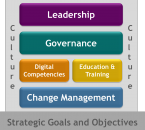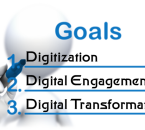[vc_row][vc_column width=”1/1″ css=”.vc_custom_1426027902717{padding-top: 10px !important;}”][vc_row_inner][vc_column_inner width=”1/4″][vc_column_text] [/vc_column_text][/vc_column_inner][vc_column_inner width=”3/4″][vc_column_text]Rather than viewing the impact of technological innovation on established firms as either competence-destroying or competence-enhancing, business leaders should consider their competence-extending possibilities. This article explores the notion and provides examples of businesses that have successfully adapted their strategies to incorporate new social and digital technologies.[/vc_column_text][/vc_column_inner][/vc_row_inner][vc_column_text css=”.vc_custom_1426018767894{border-top-width: 1px !important;padding-top: 10px !important;border-top-color: #d6d6d6 !important;border-top-style: solid !important;}”]It’s hard to believe, but almost twenty years ago I published an academic article with Howard Aldrich that used examples from the then-burgeoning World Wide Web to illustrate how organizational communities are created and evolve.
[/vc_column_text][/vc_column_inner][vc_column_inner width=”3/4″][vc_column_text]Rather than viewing the impact of technological innovation on established firms as either competence-destroying or competence-enhancing, business leaders should consider their competence-extending possibilities. This article explores the notion and provides examples of businesses that have successfully adapted their strategies to incorporate new social and digital technologies.[/vc_column_text][/vc_column_inner][/vc_row_inner][vc_column_text css=”.vc_custom_1426018767894{border-top-width: 1px !important;padding-top: 10px !important;border-top-color: #d6d6d6 !important;border-top-style: solid !important;}”]It’s hard to believe, but almost twenty years ago I published an academic article with Howard Aldrich that used examples from the then-burgeoning World Wide Web to illustrate how organizational communities are created and evolve.
I recently re-read the piece and was pleasantly surprised to discover how well it has stood the test of time. Though some of the examples now seem quaint and a bit antiquated (remember UUnet or the Alta Vista search engine?), our core ideas and theoretical assertions are still valid today – not just from an academic perspective, but also with respect to how things work in the “real world.”
One of the concepts we introduced in the article has continued to resonate with me, and I think it’s particularly important to consider given the media attention and ongoing emphasis on technological innovation as a disruptive force.[/vc_column_text][/vc_column][/vc_row][vc_row][vc_column width=”1/1″][vc_column_text css=”.vc_custom_1426018874558{padding-bottom: 5px !important;}”]
Introducing the Notion of Technological Innovation as Competence-Extending
[/vc_column_text][vc_column_text]Here’s an updated version of what we had to say in 1998…
For established organizations, the consequences of innovation have typically been described as incremental and therefore competence-enhancing, or radical and therefore competence-destroying. Innovations that are based on new substantive knowledge presumably post major problems for existing firms in mature industries, because their routines and competencies may not be flexible enough for them to adapt to the changes required. By contrast, innovations that represent improvements, minor modifications, or extensions of existing knowledge presumably permit many existing organizations to survive by adapting to the minimal changes required.
Technological innovations need not be competence-enhancing or competence-destroying, however. They can also create opportunities for established players to expand their competencies by leveraging significant innovations themselves. Thus, rather than a simple dichotomy between competence-destroying and competence-enhancing innovations, we propose a third category of innovations: competence-extending. From our perspective, competence-extending innovations permit existing firms to pursue new opportunities that allow them to stretch their existing competencies into complementary initiatives and ventures. Unlike competence-enhancing opportunities, these new pursuits are not a natural or simple extension of current capabilities and cannot therefore be pursued with minimal effort. At the same time, however, the related innovations are not necessarily direct threats to existing business pursuits and competencies. Instead, they are potential opportunities to expand by pursuing new markets and/or creating and exploiting new competencies.
The early evolution of the web provides many examples of the ways in which existing firms jumped on the internet bandwagon in an effort to establish new commercial niches for themselves. One of the most dramatic examples is Bill Gates’s decision to officially change Microsoft’s strategic direction from PC-based software to an almost-exclusive focus on Web-based technology, a decision he made after witnessing the phenomenal success of Netscape. AT&T also made a major strategic decision to become an internet service provider, a decision that was also made by almost all of the regional phone companies. Although these decisions involved the creation of new business units, they were logical extensions of the firms’ existing capabilities. In a similar fashion, many public relations and advertising firms decided to leverage their knowledge of media into the web environment by adding competencies for website design and maintenance. These pursuits were not simply an enhancement of existing competencies, but rather were entirely new ways that these firms could capitalize on their existing skills/knowledge base, as well as their existing resources, to enter a new commercial niche.[/vc_column_text][/vc_column][/vc_row][vc_row][vc_column width=”1/1″][vc_column_text css=”.vc_custom_1426019028558{padding-bottom: 5px !important;}”]
Competence-Extending Innovation Responses Continue Today
[/vc_column_text][vc_column_text]Over the past five to ten years in particular, the news has been dominated by stories of how industries and organizations have been negatively affected by disruptive innovation and competence-destroying technological change. Examples include the impact of internet-based file sharing services on the record industry, blogging and web-based news on print journalism, digital books on traditional book publishing, and “sharing economy” services on the taxi industry.
But those aren’t the only noteworthy stories. Though they get less attention, there are great examples of how established organizations are adapting to technological innovations by extending their core competencies. In some cases it’s a matter of moving what they have historically done into a new, digitally-focused area (with related required modifications). In others it involves expansions of – and maybe even revisions to – their strategy and business models. Here are some examples:
- Focusing on its purpose to provide a fabulous customer experience by empowering customers and the employees who serve them, Nordstrom has persistently leveraged social and digital technologies to digitally transform their business model and operations since the 1990s. (learn more here)
- Over the past four years, both Christie’s and its rival Sotheby’s have invested heavily in extending their in-person auction experiences to online-only sales. (learn more here)
- Recognizing that “we live not in the digital, not in the physical, but in the kind of minestrone that our mind makes of the two,” museums like New York’s Metropolitan Museum of Art are “being redefined for a digital age…. from how art and objects are presented and experienced to what is defined as art.” (learn more here)
- By identifying themselves as a “premium brand with high quality content” rather than a newspaper, the Financial Times treats print as “one channel among many for reaching their customers.” By treating smartphones, desktops, and tablets as equally important channels and creating a multi-media approach to content distribution, the company has emerged as a global digital media leader. (learn more here)
- Many banks, like Lloyds in the UK, are undergoing massive digital transformations that aim to integrate technology throughout their offerings and operations while maintaining a “relentless emphasis on customer-centricity and the new relationship that digital creates between bank and clients.” (learn more here and here)
- Building on their past successes and related competency with audiobooks, Audible is developing products for “an emerging art form that blends the immersive charm of old-time radio drama with digital technology.” (learn more here)
- Management consultants, digital agencies, and IT service providers are all “massively overhauling their competitive strategies” in a “race to win the position of preferred digital transformation partner and offer services in all three domains – strategy, design and technology.” (learn more here)
[/vc_column_text][/vc_column][/vc_row][vc_row][vc_column width=”1/1″][vc_column_text css=”.vc_custom_1426018975713{padding-bottom: 5px !important;}”]
Treating Technological Innovation as a Competence-Extending Opportunity
[/vc_column_text][vc_column_text]As many of the preceding examples illustrate, technological innovations can be competence-destroying if organizations don’t extend their core capabilities to leverage them. The Financial Times, for example, is the exception among traditional news publishers who have struggled to adapt to the shift from print to digital. Recasting themselves as a content provider, extending their view of publication channels from the earth to the cloud, and investing in a multi-media strategy has enabled them to thrive in the face of potential disruptive threats.
A digitally-focused shift in strategic direction may not make sense for many organizations, but the possibilities are still worth exploring. At first blush, for example, it may not seem that a company like WasteManagement could incorporate digital technologies into its business model in competence-extending ways, but what if they could take some of the recyclable material they receive and use that as the raw material to establish their own 3D printing operations – or perhaps to supply the operations of others?
All too often organizational leaders fail to see the competence-extending potential of technological innovations and therefore don’t consider the upside potential of pursuing them (for more on this idea, click here). That kind of conservative approach may prevent big losses in the short term, but it also precludes the possibility of big wins and could lead to big losses over the longer term.
This essay originally appeared on Social Media Today as part of their Best Thinkers program.[/vc_column_text][divider_line type=”divider_line”][/vc_column][/vc_row]





